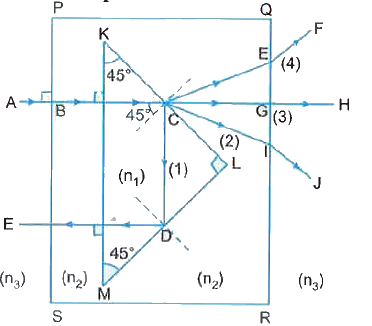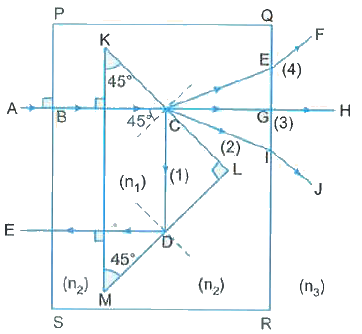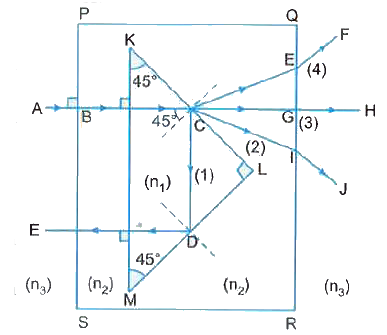CASE BASED/SOURCE- BASED INTEGRATED QUESTIONS from U-LIKE PHYSICS Chapter 22 RAY OPTICS AND OPTICAL INSTRUMENTS for Class 12
| Class 12 | PHYSICS |
| Chapter | RAY OPTICS AND OPTICAL INSTRUMENTS |
| U-LIKE PHYSICS | CASE BASED/SOURCE- BASED INTEGRATED QUESTIONS |
| Medium | English |
| Academic Year | 2023-2024 |
Question 1
When an object is placed normally on the principal axis of a spherial mirror at a distance 'a' from its pole, its image is formed at a distance 'v' from the pole of mirror such that 1v+1u=1f, where f = focal length of given mirror.
The relation is called mirror formula and is true for all types of mirrors under all conditions. However, values of u, v and f must be put with proper signs are per the sign convention followed. If 'h' be the height of the linear object and h' the height of image, then ratio h'h is called linear magnification or lateral magnification and its value m is given as :
m=h'h=−vu
(a) A planer object of length 3 cm and breadth 2 cm is held normal to the principal axis of a concave mirror of focal length 20 cm at a distance of 30 cm from its pole. Where is its image formed?View SolutionQuestion 2
When an object is placed normally on the principal axis of a spherial mirror at a distance 'a' from its pole, its image is formed at a distance 'v' from the pole of mirror such that 1v+1u=1f, where f = focal length of given mirror.
The relation is called mirror formula and is true for all types of mirrors under all conditions. However, values of u, v and f must be put with proper signs are per the sign convention followed. If 'h' be the height of the linear object and h' the height of image, then ratio h'h is called linear magnification or lateral magnification and its value m is given as :
m=h'h=−vu
What is the surface area of image of linear object formed by the given concave mirror?View SolutionQuestion 3
When an object is placed normally on the principal axis of a spherial mirror at a distance 'a' from its pole, its image is formed at a distance 'v' from the pole of mirror such that 1v+1u=1f, where f = focal length of given mirror.
The relation is called mirror formula and is true for all types of mirrors under all conditions. However, values of u, v and f must be put with proper signs are per the sign convention followed. If 'h' be the height of the linear object and h' the height of image, then ratio h'h is called linear magnification or lateral magnification and its value m is given as :
m=h'h=−vu
A small match box lies along the principal axis of a concave mirror and one end of match box is at centre of curvature of the mirror. Draw a ray diagram to show its image. Is its magnetification uniform?View SolutionQuestion 4
When an object is placed normally on the principal axis of a spherial mirror at a distance 'a' from its pole, its image is formed at a distance 'v' from the pole of mirror such that 1v+1u=1f, where f = focal length of given mirror.
The relation is called mirror formula and is true for all types of mirrors under all conditions. However, values of u, v and f must be put with proper signs are per the sign convention followed. If 'h' be the height of the linear object and h' the height of image, then ratio h'h is called linear magnification or lateral magnification and its value m is given as :
m=h'h=−vu
(d) Define longitudinal magnification.View SolutionQuestion 5
When an object is placed normally on the principal axis of a spherial mirror at a distance 'a' from its pole, its image is formed at a distance 'v' from the pole of mirror such that 1v+1u=1f, where f = focal length of given mirror.
The relation is called mirror formula and is true for all types of mirrors under all conditions. However, values of u, v and f must be put with proper signs are per the sign convention followed. If 'h' be the height of the linear object and h' the height of image, then ratio h'h is called linear magnification or lateral magnification and its value m is given as :
m=h'h=−vu
(e) Find an expression for longitudinal magnification of a small object placed linearly along the axis of a spherical mirror.View SolutionQuestion 6
Lens maker's formula is a formula corelating the power P (or focal length f) of a lens to radii of curvature of the two surfaces of the lens and the refractive index of lens material with respect to its surroundings. The formula is expressed as :
P=1f=(n−1)(1R1−1R2)
where n = refractive index of the material of lens with respect to its surroundings (ordinarily air) and R1andR2 are the radii of curvature of two surfaces of the lens. The relation is true under all conditions but while applying it we should put values of P, f, R1andR2 with their proper signs as per sign convention being followed by us.
Let us have a bi- convex lens and let radii of curvature of both its curved surfaces is same i.e., |R1|=|R2|=R (say)
Let the given biconvex lens be divided in two equal parts, as shown in Fig. (a), along a section YY' which is perpendicular to the principal axis of lens. What is the power of each part?
 View Solution
View SolutionQuestion 7
Lens maker's formula is a formula corelating the power P (or focal length f) of a lens to radii of curvature of the two surfaces of the lens and the refractive index of lens material with respect to its surroundings. The formula is expressed as :
P=1f=(n−1)(1R1−1R2)
where n = refractive index of the material of lens with respect to its surroundings (ordinarily air) and R1andR2 are the radii of curvature of two surfaces of the lens. The relation is true under all conditions but while applying it we should put values of P, f, R1andR2 with their proper signs as per sign convention being followed by us.
Let us have a bi- convex lens and let radii of curvature of both its curved surfaces is same i.e., |R1|=|R2|=R (say)
How is your answer modified if the given biconvex lens is divided into two parts along a section XX' along its principal axis ?View SolutionQuestion 8
Lens maker's formula is a formula corelating the power P (or focal length f) of a lens to radii of curvature of the two surfaces of the lens and the refractive index of lens material with respect to its surroundings. The formula is expressed as :
P=1f=(n−1)(1R1−1R2)
where n = refractive index of the material of lens with respect to its surroundings (ordinarily air) and R1andR2 are the radii of curvature of two surfaces of the lens. The relation is true under all conditions but while applying it we should put values of P, f, R1andR2 with their proper signs as per sign convention being followed by us.
Let us have a bi- convex lens and let radii of curvature of both its curved surfaces is same i.e., |R1|=|R2|=R (say)
If twoplanoconvex lenses fromed as a result of (a) are joined together as shown in Fig. (b), what is the net power of the combination ?
 View Solution
View SolutionQuestion 9
Lens maker's formula is a formula corelating the power P (or focal length f) of a lens to radii of curvature of the two surfaces of the lens and the refractive index of lens material with respect to its surroundings. The formula is expressed as :
P=1f=(n−1)(1R1−1R2)
where n = refractive index of the material of lens with respect to its surroundings (ordinarily air) and R1andR2 are the radii of curvature of two surfaces of the lens. The relation is true under all conditions but while applying it we should put values of P, f, R1andR2 with their proper signs as per sign convention being followed by us.
Let us have a bi- convex lens and let radii of curvature of both its curved surfaces is same i.e., |R1|=|R2|=R (say)
If two lens parts obtained in (b) are joined together as shown in Fig. (c), (i) what is the net power of the combination?
 View Solution
View SolutionQuestion 10
Lens maker's formula is a formula corelating the power P (or focal length f) of a lens to radii of curvature of the two surfaces of the lens and the refractive index of lens material with respect to its surroundings. The formula is expressed as :
P=1f=(n−1)(1R1−1R2)
where n = refractive index of the material of lens with respect to its surroundings (ordinarily air) and R1andR2 are the radii of curvature of two surfaces of the lens. The relation is true under all conditions but while applying it we should put values of P, f, R1andR2 with their proper signs as per sign convention being followed by us.
Let us have a bi- convex lens and let radii of curvature of both its curved surfaces is same i.e., |R1|=|R2|=R (say)
How is result of part (d) modified if two parts are placed together as shown in Fig. (c)(ii)?
 View Solution
View SolutionQuestion 11
Answer question (a) - (e) on the basis of data given in the following table and your understanding of the relation studied concepts :
In a school laboratory following lenses are available :

All these lenes are converging lenses.
Which two lenses would you select to design a compound microscope and why?View SolutionQuestion 12
Answer question (a) - (e) on the basis of data given in the following table and your understanding of the relation studied concepts :
In a school laboratory following lenses are available :

All these lenes are converging lenses.
Which two lenses would you choose to prepare an astronomical telescope? Give reason for your choice.View SolutionQuestion 13
Answer question (a) - (e) on the basis of data given in the following table and your understanding of the relation studied concepts :
In a school laboratory following lenses are available :

All these lenes are converging lenses.
Draw the ray diagram for image formation of a far off object in normal arrangement of astronomical telescope.View SolutionQuestion 14
Answer question (a) - (e) on the basis of data given in the following table and your understanding of the relation studied concepts :
In a school laboratory following lenses are available :

All these lenes are converging lenses.
(d) What should be teh distance between objective and eye piece of your telescope and what is the expected value of its magnifying power?View SolutionQuestion 15
Answer question (a) - (e) on the basis of data given in the following table and your understanding of the relation studied concepts :
In a school laboratory following lenses are available :

All these lenes are converging lenses.
Why do we prefer an objective lens of large aperature in a telescope?View SolutionQuestion 16
A ring angled isosceles prism KLM of refractive index n1 is placed inside a rectangular block PQRS of refractive index n2 as shown in the adjoining Fig. The rectangular box is surrounded by a medium of refractive index n3. A ray of light AB enters the rectangular block normally. Depending upon the relationships between n1,n2andn3. it takes one of the four possible paths.

Under what condition the ray follows the path no. 1 (i.e., path ABCI)?View SolutionQuestion 17
A ring angled isosceles prism KLM of refractive index n1 is placed inside a rectangular block PQRS of refractive index n2 as shown in the adjoining Fig. The rectangular box is surrounded by a medium of refractive index n3. A ray of light AB enters the rectangular block normally. Depending upon the relationships between n1,n2andn3. it takes one of the four possible paths.

Under what condition the ray follows the path no. 2 (i.e., path ABCIJ)?View SolutionQuestion 18
A ring angled isosceles prism KLM of refractive index n1 is placed inside a rectangular block PQRS of refractive index n2 as shown in the adjoining Fig. The rectangular box is surrounded by a medium of refractive index n3. A ray of light AB enters the rectangular block normally. Depending upon the relationships between n1,n2andn3. it takes one of the four possible paths.

State the condition for light ray to travel along path no. 3 (i.e., path ABCGH).View SolutionQuestion 19
A ring angled isosceles prism KLM of refractive index n1 is placed inside a rectangular block PQRS of refractive index n2 as shown in the adjoining Fig. The rectangular box is surrounded by a medium of refractive index n3. A ray of light AB enters the rectangular block normally. Depending upon the relationships between n1,n2andn3. it takes one of the four possible paths.

What is the condition for light ray to proceed along the path no. 4 (i.e., path ABCEF)?View Solution
All Exercises from U-LIKE PHYSICS Class 12 PHYSICS RAY OPTICS AND OPTICAL INSTRUMENTS
- ASSERTION-REASON TYPE QUESTIONS
- CASE BASED/SOURCE- BASED INTEGRATED QUESTIONS
- FILL IN THE BLANKS
- LONG ANSWER QUESTIONS-I
- LONG ANSWER QUESTIONS-II
- MULTIPLE CHOICE QUESTIONS
- N.C.E.R.T. TEXTBOOK EXERCISES
- SELF ASSESSMENT TEST (SECTION A)(FILL IN THE BLANKS)
- SELF ASSESSMENT TEST (SECTION A)(MULTIPLE CHOICE QUESTIONS)
- SELF ASSESSMENT TEST (SECTION B)
- SHORT ANSWER QUESTIONS
- TRUE OR FALSE
- VERY SHORT ANSWER QUESTIONS
